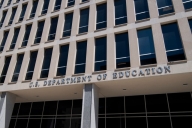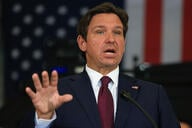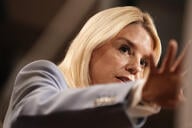You have /5 articles left.
Sign up for a free account or log in.

Istockphoto.com/KeithSzafranski
The gloves have already come off in the wake of massive cuts planned for the University of Alaska system, with the Faculty Senate at the university’s largest campus in Anchorage issuing a report detailing why the smaller research campus in Fairbanks should bear the brunt of the financial reduction.
Fairbanks officials were none too pleased.
In late June, Governor Mike Dunleavy vetoed portions of the Alaska Legislature’s state budget -- causing an unprecedented 41 percent cut to the University of Alaska system. Last week, legislators failed to override the governor’s veto. Now, as major financial issues loom closer, infighting has already begun between institutions within the system -- as is often the case in higher education when money gets tighter.
The Anchorage campus's Faculty Senate committee on governance and funding reform released a report last week detailing opinions on how the system should handle the cuts -- and it asserts that the University of Alaska Fairbanks should absorb much of the pain.
Among several recommendations within the report, the committee calls on the university system to apportion funds based on the number of full-time-equivalent students at each campus. The committee said that at Anchorage and University of Alaska Southeast, the smallest of the three campuses, this would mean funding continuing at the previous year's level despite the cuts. However, Fairbanks would receive a significant reduction. The report said that 70 to 80 percent of students in the Alaska system would be able to continue their education as a result of this recommendation.
“Admittedly, UAF would bear the brunt of the cuts,” the committee wrote. “Probably, it will be necessary to declare a state of financial exigency at UAF or for some units that are a part of UAF.”
The report acknowledges that its recommendations would result in "financial vulnerability for the Fairbanks campus" -- but suggests that the susceptibility would result from what it calls "historically unequal" funding that has benefited the Fairbanks campus. According to the report, the Fairbanks campus was funded at a rate of $34,845 per student while Anchorage was funded at a rate of $11,540 per student. The report defines this financial vulnerability through a comparison to UA Anchorage -- pointing to the fact that Anchorage has had to adapt to funding cuts while Fairbanks has not.
“These disparate allocations have encouraged inefficiency in the one institution and efficiency in the other,” the committee wrote.
Tension Has Built
The committee’s report seemed to reveal further animosity between the two campuses, including that cuts in recent years have been generally levied at Anchorage rather than Fairbanks.
Among the other recommendations made in the report, the committee expressed the belief that the Alaska university system should decentralize, blowing up the system office in favor of independent universities with separate governing boards, which the committee said would lead to better financial health at each institution.
Forrest Nabors, an Anchorage political science professor and chair of the committee that created the report, said it was a "false assumption" that the two campuses weren't competing already. Decentralization would lead to healthier competition, he argued.
"Our belief is that when we become independent institutions, our competition will be healthy, and that each of us will be more responsive to the market and will each concentrate on our strengths," Nabors said. "We will be more complementary. UAF and UAA each has unique strengths, and I see no reason why we cannot thrive and collaborate as independent institutions."
Nabors said that no ill will drove the creation of the report, and that recognizing problems was necessary in a time like this.
"I cannot emphasize enough that we do not wish ill to anybody. Faculty, staff and students at UAF are our colleagues, fellow citizens and fellow Alaskans," Nabors said. "We want the best for all of us. We sympathize with them. We have reached out to them to work in common towards a better future for our system. Our dependence on state aid and this abrupt and deep cut to our state aid is the cause of this division. To remove ourselves from this dependency, we must reform. That has been the sentiment of our faculty for years."
Anchorage chancellor Cathy Sandeen said in an emailed statement that the opinions expressed in the report are representative of the committee’s opinion and not necessarily the university’s. Sandeen's statement avoided a direct question about whether Anchorage administrators supported the report or not.
"Under our model of shared governance, faculty, staff and students have the right to come together, form committees and make recommendations on any number of topics or issues. We are committed to an inclusive process and welcome diversity of thoughts and opinions -- especially in this time of budget uncertainty and reinvention,” Sandeen said in the email. “The UAA Faculty Senate took time to provide an analysis based on publicly available data. The opinions and recommendations are their own. It is up to the UA Board of Regents and state elected officials to decide on a path forward based on all the various reports and recommendations they receive.”
In an emailed statement, Fairbanks Chancellor Dan White didn't respond directly to the report but instead simply said those considering UA Fairbanks budget to work with the Fairbanks campus officials to make sure the proposals are "well informed."
"There are many different opinions on how to meet the budget deficit facing UA," White said. "We would encourage those writing proposals about UAF's budget to work directly with us so that the proposals are well informed to the greatest extent possible. At UAF we support our faculty to work across the system in a collaborative and constructive manner."
Response From Fairbanks
Sine Anahita, a UA Fairbanks professor of sociology and president of the Fairbanks Faculty Senate, said his group chose not to respond by releasing a similar report but instead to email the UA Board of Regents to share opinions about the UA Anchorage committee report.
“It is true that the budget crisis has set people on edge across the system. There is deep anxiety, as we are facing massive layoffs and program closures. Some of our colleagues have reacted to the stress by striking out at others,” Anahita said. “But the leadership at UAF -- both governance leaders and administrative leaders -- believe deeply in the power of solidarity, unity and community. While we will correct misinformation as needed, and we will promote UAF's interest, we will not do so at the expense of other campuses.”
In an April interview with Inside Higher Ed, Alaska system president Jim Johnsen pointed to the fact that the different campuses in the Alaska system were distinctive within the state. This could often lead to tension, as Fairbanks is the system’s main research university -- terrain that officials at the Anchorage campus have often expressed desire to expand into.
“My philosophy has always been stay in your lane and do more,” Johnsen said of the two universities. “Let’s educate more nurses; let’s educate more engineers and accountants. Our state needs you for that. We already have one research university, and our board has supported that, generally speaking. There are really interesting research programs that the federal government funds that do ask us to reach out and partner with the other universities.”




